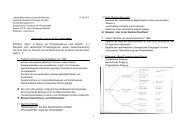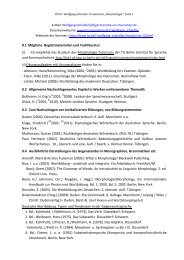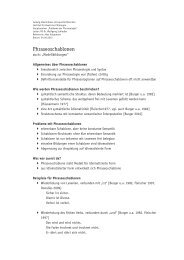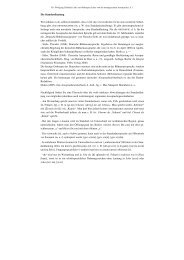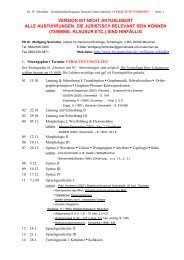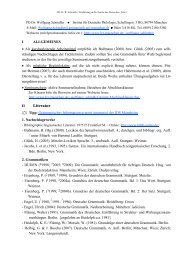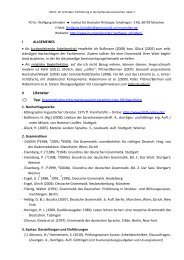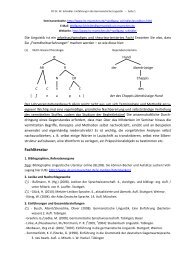Chapter 18 Lexical Functions: Description of Lexical Relations in a ...
Chapter 18 Lexical Functions: Description of Lexical Relations in a ...
Chapter 18 Lexical Functions: Description of Lexical Relations in a ...
You also want an ePaper? Increase the reach of your titles
YUMPU automatically turns print PDFs into web optimized ePapers that Google loves.
Means noun ((δ) = (means [for L]))<br />
—<strong>Chapter</strong> <strong>18</strong>. <strong>Lexical</strong> <strong>Functions</strong>— 9<br />
Sew ~ thread; wash ~ water, soap, shampoo, detergent; fry ~ oil, butter; shoot ~ ammunition; ...<br />
[none <strong>of</strong> these is a morphological derivation]<br />
1.3 Collocations<br />
Syntagmatic lexical correlates {L´i | 1 ≤ i ≤ n}SYNTAGM <strong>of</strong> L, comb<strong>in</strong>ed with L, form collo-<br />
cations, that is, phraseological expressions <strong>of</strong> the type <strong>of</strong> those underscored <strong>in</strong> (1) [L is <strong>in</strong><br />
small capitals]:<br />
(1) a. The President imposed a CURFEW on three areas ... <strong>in</strong> order to stamp out 〈= put<br />
down〉 the VIOLENCE.<br />
b. The panel issued a REPORT to the Secretary <strong>of</strong> State.<br />
c. The President rejected PLEAS to open TALKS with strik<strong>in</strong>g US air traffic controllers.<br />
d. The heaviest prison TERMS <strong>in</strong> Kansas history have been handed down aga<strong>in</strong>st two men.<br />
e. Government troops have spread a DRAGNET across the country <strong>in</strong> a SEARCH for three<br />
heavily ARMED guerillas. The FARC has claimed RESPONSIBILITY for the ATTACK<br />
launched Tuesday <strong>in</strong> which four ROCKETS were fired at an ARMY camp.<br />
Syntagmatic lexical correlates can be considered as a sort <strong>of</strong> ‘addition’ to L or ‘charac-<br />
terization’ <strong>of</strong> L. If L designates a situation or an object, an L´ designates a property or a state <strong>of</strong> L<br />
or else an action that the referent <strong>of</strong> L can accomplish or that can be carried out on the referent <strong>of</strong><br />
L. Thus:<br />
• L = SCHOOLN<br />
{L´ j }SYNTAGM = {HIGH (school), ELEMENTARY/GRAMMAR (school), TEACH (elementary/high<br />
• L = ESCAPEN<br />
school), GO (to school), GRADUATE (from a school), ...}<br />
{L´ j } SYNTAGM = {DARING (escape), GREAT (escape), MAKE (an escape), THWART (an escape), ...}<br />
These lexical correlates <strong>of</strong> L are, as a rule, used <strong>in</strong> text together with L.<br />
Texts—from colloquial to artistic to journalistic to technological—swarm with expressions<br />
<strong>of</strong> the type illustrated <strong>in</strong> (1): phrases conta<strong>in</strong><strong>in</strong>g L and lexical correlates <strong>of</strong> L that show colloca-<br />
tional relationships with L. Collocations are described <strong>in</strong> <strong>Chapter</strong> 19; here I will limit myself to<br />
simply reproduc<strong>in</strong>g, for the reader’s convenience, the def<strong>in</strong>ition <strong>of</strong> the notion.



![E-Mail: Wolfgang.Schindler[ätt]germanistik.uni-muenchen.de Web ...](https://img.yumpu.com/51590147/1/184x260/e-mail-wolfgangschindlerattgermanistikuni-muenchende-web-.jpg?quality=85)
